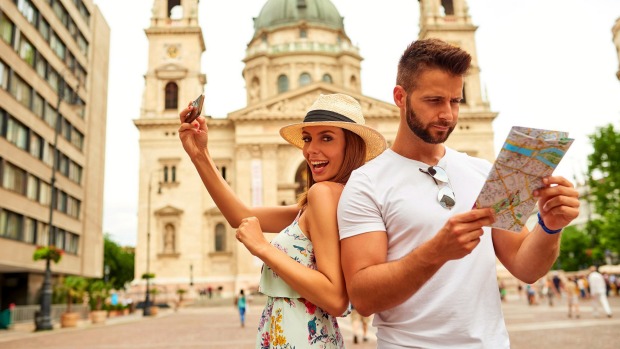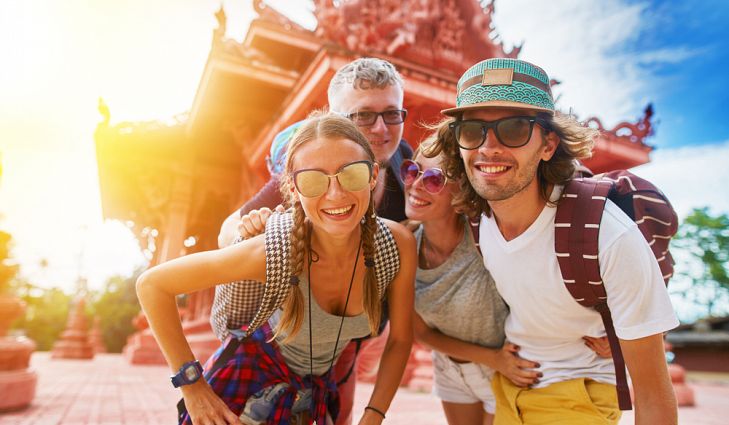

Business Tourism
Welcoming Tourists

Read the passages about “Leonardo and the Thai Wai”
The Thai sign of salutation or mutual recognition is to raise both hands, joined palm to palm, lightly touching the body somewhere between the face and chest. The higher the hands are raised, the greater is the respect and courtesy conveyed. The person who is inferior in age or rank in the social scale of precedence initiates such a movement of the hands and the person receiving the salutation immediately recipocrates. The Thai salutation may be rendered while sitting, standing, walking or even lying in bed during illness. In rendering a salutation while standing to a most respected person who is sitting, one, as a decorum of good manners, will stoop r bend the head at the same time. When taking leave, the departing person will offer salute in the same manner, followed in turn by a corresponding salute of the other person. Such a salutation is called a wai in Thai, and is often seen in Thai society.

When to wai. The question of when to wai and how to wai is learnt from the days of childhood. It of childhood. It comes naturally for a Thai, but is a problem for the visitor. A waiis not only reserved for greetings and farewells, but for a manner of other reasons too. When q is receiving anything from a senior, he will raise his hands as a wai to the giver as a
Polite gesture of thanks before or after receiving it as circumstances demand.When someone is asking someone’s pardon or favor, one usually makes such a wai too. During a Buddhist sermon, monks and lay persons will sit respectfully with their hands to chest level in a wai. A group of students passing their teacher at school will come smartly to attention and wai and bow with almost military precision. On buses and in taxis passengers wai sacred places and revered statues of past kings as they pass by. Even the drivers quickly take their hands of the wheel for a quick wai to a shrine put up to protect road users.
Who to wai. The best advice to farang (westerners) in Thailand is that unless you receive a wai first, stick to the handshake with men and a polite smile with women. As you spend more time in Thailand you will soon learn some important rules:
1. Do not wai servants, labourers, children and other people of an obviously lower social status than yours
2. If you receive a high wai, reply with a lower wai.
3. The safest people to wai are monks and the very old (but not if they are your servants or street vendors!).
4. The appropriate deference position is shown by lowering the head and body, not by raising the hands.
5. Remember, a wai is not a hello’. Overuse would devalue its meaning.

How to Wai Children are taught at a very early age how to show the proper respect to their seniors. They are drilled in both the home and at school to perform the wai correctly. The following pictures demonstrate how to wai correctly. For a foreigner, it is best to bring your hands up so that your thumbs are at about nose level. You might also like to bend forward slightly depending on how much respect you want to show. The picture above of Leonardo giving a wai to the press was correctly done and was much appreciated by all of.
Activity: Look at the following conversation about do’s and don’t in Thailand try to use the above information to write your own conversation.
Situation 1
Mr. Somphon and Ms. Supreeya. A tour guide from NU Travel Company, is assigned to pick up a group of American tourists at Chiang Mai International Airport.
Supreeya: Good morning, ladies and gentlemen world of Thailand.I hope you had a pleasant flight an that you will enjoy your stay here. My name is Supreeya Supreeya Supap, and I, along with Mr. Somphop Wongchai, will be your tour guide. The first thing I would like to do before we depart for the hotel is to bid you welcome Thai-style Sawatdee-ca.
Supreeya: What a pleasant way to welcome someone. Why do you greet someone by putting your hands together in a prayer-like fashion?
Supreeya: That is the way all Thai greet each other. It is called “WAI”. This is a way of showing respect to those we greet
Tourist: May I try it?
Supreeya: By all means
Tourist: Sawatdee-ca!
Supreeya: Very good! You did only one thing incorrectly
Tourist: Oh? What was that?
Supreeya: You said “ca”.
Tourist: Isn’t that what you said?
Supreeya: Yes, I did. But you see, only women say “ca. Men say “krab”.Try it.
Tourist: Krab.
Supreeya: That’s right.
Tourist: What do “ca” and “krab” mean?
Supreeya: “ca” and “krab” indicate that the speaker wishes to be polite. They are rather like the English words “sir” and “ma’am. They are also used to indicate agreement or to answer “yes”
Tourist: So many uses for small words,
Supreeya: Yes, but those little words carry a lot of weight in conveying respect! Well, shall we leave for the hotel? I see our bus has arrived.
Situation 2
Ms. Supreeya explains about some Thai customer to the tourists on the bus.
Tourist: Well, you’ve taught us how to greet people properly, what else should we know about Thai customs?
Supreeya: First of all, don’t point your foot at a person. The feet are considered the lowest part of the body, and to point them at people is rude.
Tourist:Well, there should be no problem then since none of us use our feet to point with.
Supreeya: You may not think to do, but you do. You are now, as a matter of fact!
Tourist: What do you mean? I’m simply sitting!
Supreeya: Yes, but you are sitting with your legs crossed, and one foot is up pointing directly at the lady sitting opposite you.
Tourist: I suppose you’re right, but the pointing isn’t intentional.
Supreeya: I understand, but others may not, so it’s best to try to avoid your legs when sitting opposite someone.
Tourist: I’ll certainly try to remember. I wouldn’t want to offend anyone.
Supreeya: Another thing you should remember is to avoid patting people on the head, even in a friendly gesture.
Tourist: Why?
Supreeya: Well, just as the feet are considered the lowest part of the body, the head is considered the highest and should be accorded all due respect. Touching someone’s head indicates a lack of respect for that person.
Tourist: How interesting.
Supreeya:When we tour places that have social gatherings, if you’ll look carefully, you’ll notice that the young people go to considerable lengths to keep their heads lower than those of the older people. Tourism:Another sign of respect?
Supreeya:That’s right. The young want to avoid giving the impression of looking down on the old.
Tourist: What marvelous customs? We could certainly do with a few of those in our country.
Supreeya: We have worked very hard to maintain our customs in spiteof westernization, especially in Bangkok. We believe that with our Supreeya customs and modern western conveniences, we now have the best of both worlds! Oh, we’ve arrived. Let’s get you checked into the hotel.

จัดทำโดย
นางสาว ธัญลักษณ์ กล้าหาญ BE 3/2
โพสโดย
นางสาว ศุภลักษณ์ ชาติชาวนา BE 3/2
